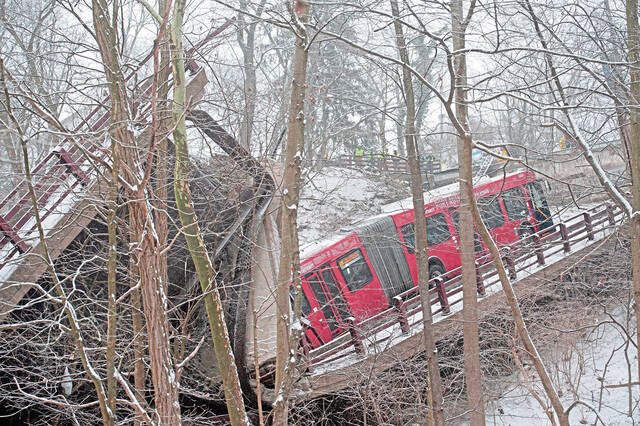https://development.triblive.com/opinion/falco-muscante-ii-what-do-fern-hollow-bridge-and-u-s-steel-tower-have-in-common/
Falco Muscante II: What do Fern Hollow Bridge and U.S. Steel Tower have in common?

On Feb. 7, the National Transportation Safety Board (NTSB) released a preliminary report on the Jan. 28 collapse of the Fern Hollow Bridge. The report on the failure of the not-even-50-year-old bridge spanning Frick Park was unsurprising — but for one particular footnote.
The NTSB described the bridge as “an uncoated weathering steel, three-span, continuous rigid ‘K’ frame structure with two welded steel girders, welded steel floor beams, and rolled steel stringers.” Nothing too exciting, right? Wrong. The accompanying footnote defines the uncoated weathering steel: “steel alloy … designed to, over time and with exposure to weather, form a protective patina that negates the need for painting.” This means that the steel used for the bridge was designed to intentionally rust. The rust would act as a protectant — similar to paint — to eliminate the need for any additional exterior coatings.
So, what do the Fern Hollow Bridge and the U.S. Steel Tower have in common? They are both made from uncoated weathering steel.
The Steel Tower is a stalwart in the iconic Pittsburgh skyline and is, in fact, older than the late Fern Hollow Bridge. Since its completion Sept. 30, 1971, the skyscraper has represented both our city’s rich history in steel production and our city’s technological and innovative future.
The triangular-shaped building is made of 44,000 tons of structural steel with 18 main support columns on the exterior of the building. Each of these support columns on the building’s exoskeleton is made of corten (or COR-TEN) — a type of uncoated weathering steel like that used for the Fern Hollow Bridge — and filled with half a million gallons of water and antifreeze to protect the building for up to 4 hours in the event of a fire. The steel frame harkens to the booming steel industry that gave Pittsburgh its nickname, the “Steel City,” and the shape of the building reflects Pittsburgh’s “Golden Triangle” at the confluence of the Monongahela and Allegheny Rivers.
Now, I am not an engineer and am not in any way suggesting that the Steel Tower is flawed or in any danger — comparing a skyscraper to a bridge is apples and oranges. Bridges and roads take a beating from the vibrations of the cars and trucks that travel over them each day and also the harsh road salt used to mitigate the Western Pennsylvania weather. Nonetheless, it will be interesting to read the NTSB full report to determine whether the weathering steel played any major factor in the collapse.
The Fern Hollow Bridge made national news, and the contrast between the bridge’s tragic failure and the splendor of the U.S. Steel Tower serves as a reminder of the need to preserve and maintain the aging infrastructure in our historic city that has recast itself as a technological hub.
Falco Muscante II is a student at the Duquesne University School of Law.
Copyright ©2026— Trib Total Media, LLC (TribLIVE.com)
